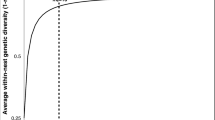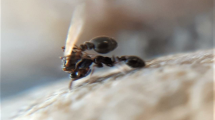Abstract
HAMILTON'S rule and the principle of inclusive fitness1 provide a theoretical basis for understanding the evolution of social behaviour, and a framework for predicting reproductive characteristics of social insect colonies2–1. Sex allocation in social insects (especially ants) has become a central factor in tests of inclusive fitness theory5–9. The most powerful such test is the analysis of individual colonies where the predicted sex allocation varies depending on variation in worker fitness functions10,11. Recently developed models5,12 predict that workers may enhance their inclusive fitness by biasing sex ratios in response to the degree of related-ness asymmetry in each colony. Here I provide the first empirical evidence of facultative sex ratio biasing in response to relatedness asymmetries caused by inter-colony variations in queen mating frequencies. In a Finnish population of the ant Formica truncovum, colonies have a single queen mated to one or several males. Colonies show a bimodal distribution of sex ratios, with a significantly greater proportion of males in colonies headed by a multiply mated queen.
Similar content being viewed by others
References
Hamilton, W. D. J. theor. Biol. 7, 1–52 (1964).
Trivers, R. L. & Hare, H. Science 191, 249–263 (1976).
Benford, F. A. J. theor. Biol. 72, 701–727 (1978).
Pamilo, P. Am. Nat. 137, 83–107 (1991).
Boomsma, J. J. & Grafen, A. Evolution 44, 1026–1034 (1990).
Nonacs, P. Q. Rev. Bio. 57, 109–133 (1986).
van der Have, T. M., Boomsma, J. J. & Menken, S. B. J. Evolution 42, 160–172 (1988).
Ward, P. S. Behav. Ecol. Sociobiol. 12, 301–307 (1983).
Pamilo, P. Behav. Ecol. Sociobiol. 27, 31–36 (1990).
Grafen, A. J. theor. Biol. 122, 95–121 (1986).
Crozier, R. H. & Pamilo, P. in Evolution and Diversity of Sex Ratio in Insects and Mites (eds Wrensch, D. L. & Ebbert, M. A.) 369–383 (Chapman Hall, New York, 1992).
Boomsma, J. J. & Grafen, A. J. evol. Biol. 3, 383–407 (1991).
Boomsma, J. J. Am. Nat. 133, 517–532 (1989).
Alexander, R. D. & Sherman, P. W. Science 196, 494–500 (1977).
Nonacs, P. Evolution 40, 199–204 (1986).
Hamilton, W. D. Science 156, 477–488 (1967).
Frank, S. A. Theor. Populat. Biol. 31, 47–74 (1987).
Frank, S. A. Behav. Ecol. Sociobiol. 20, 195–201 (1987).
Ratnieks, F. L. W. Evolution 45, 281–292 (1991).
Boomsma, J. J. Trends ecol. Evol. 6, 92–95 (1991).
Mueller, U. G. Science 254, 442–444 (1991).
Ratnieks, F. L. W. J. theor. Biol. 142, 87–93 (1990).
Brian, M. V. Social Insects (Chapman Hall, London, 1983).
Gösswald, K. Die Waldameise Vol. 1 (AULA, Wiesbaden, 1989).
Cole, B. J. Behav. Ecol. Sociobiol. 12, 191–201 (1983).
Page, R. E. A. Rev. Ent. 31, 297–320 (1986).
Sundström, L. Behav. Ecol. Sociobiol. (in the press).
Nonacs, P. in Evolution and Diversity of Sex Ratio in Insects and Mites (eds Wrensch, D. L. & Ebbert, M. A.) 384–401 (Chapman Hall, New York, 1992).
Clark, A. B. Science 201, 163–165 (1978).
Seppä, P. Behav. Ecol. Sociobiol. 30, 253–260 (1992).
Author information
Authors and Affiliations
Rights and permissions
About this article
Cite this article
Sundström, L. Sex ratio bias, relatedness asymmetry and queen mating frequency in ants. Nature 367, 266–268 (1994). https://doi.org/10.1038/367266a0
Received:
Accepted:
Issue Date:
DOI: https://doi.org/10.1038/367266a0
- Springer Nature Limited
This article is cited by
-
A novel distribution of supergene genotypes is present in the socially polymorphic ant Formica neoclara
BMC Ecology and Evolution (2022)
-
Split sex ratios and genetic relatedness in a primitively eusocial sweat bee
Behavioral Ecology and Sociobiology (2021)
-
Genetic relatedness does not predict the queen’s successors in the primitively eusocial wasp, Ropalidia marginata
Journal of Genetics (2018)
-
Sex Ratio Elasticity Influences the Selection of Sex Ratio Strategy
Scientific Reports (2016)
-
Matricide and queen sex allocation in a yellowjacket wasp
The Science of Nature (2016)





